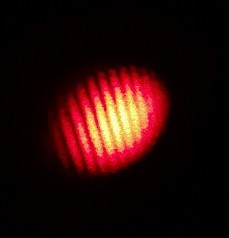As my Indium Corporation internship progresses, I am starting to notice more and more similarities to my academic experiences. I think one of the most relevant similarities is my involvement with working on MSAs (Measurement Systems Analysis), which I discussed in my last post, “A College Intern Speaking Out - and Looking In.” MSAs involve testing and analyzing our measuring devices to make sure they are accurate and precise. For my senior capstone research at Le Moyne College, I worked with probably the highest precision metrology technique in the world.
Interferometry uses the interference of light to detect and measure tiny changes, even on the scale of nanometers. Not only does interferometry detect these changes, but the measurements taken from interferometry are extraordinarily accurate. It works by taking a single laser beam, using a beam splitter to cut it into two beams that each hit a mirror 90 degrees from each other, bounce back, and recombine at the beam splitter (when at perfect alignment), and display onto a screen a single beam with an interference pattern, called fringes.

There are several different setups for interferometry. but the one I just discussed specifically describes the most well-known setup, the Michelson Interferometer. Many experiments can be conducted by slightly adjusting the mirrors (in some way, shape, or form) and studying how the fringes change. Some of the interferometric experiments I conducted during my capstone experience include:
- Detecting magnetostriction
- Determining the coefficient of thermal expansion
- Measuring indices of refraction of transparent slabs and gases
- The electro-optic effect (Kerr and Pockels effects)
- Applications of piezoelectricity (in the pursuit of the nanometer)
I grew quite the impatient love-hate relationship with interferometry after spending countless hours during the day and overnight working on experiment after experiment alone in my icy-cold private optics lab in the basement of Le Moyne College. However, there is not a day that goes by that I do not miss working with interferometry and optics.
Interferometry can be much, much more powerful than what I used it for. LIGO (Laser Interferometer Gravitational-Wave Observatory) is a national facility that uses interferometry for gravitational-wave research. LIGO has two interferometers; one in Livingston, Louisiana and the other in Hanford, Washington. Each facility has arm lengths of 4 kilometers and a laser beam the width of a proton. In September of 2015, LIGO proved the basis of Albert Einstein’s theory of general relativity for the first time and discovered gravitational waves. Both sites detected the same signal within 7 milliseconds of each other for a period of 0.2 second. Amazingly, LIGO detected the wave just days before the first actual experiment was even expected to start and they were able to determine just from the tiny wave-pulse where it came from, what caused it, when the waves originated, why it happened, and how it affects the entire universe and our knowledge of it. Scientists were able to discover that the gravitational waves LIGO detected came from two colliding black holes in which, when orbiting around each other before colliding, caused an emission of energy produced in the form of gravitational waves of about 3 times the mass of the Sun. The black holes were about 29 and 36 times the mass of the Sun, and the wave that was detected had about 50 times the entire power of the visible universe. 1.3 billion years later, the wave reached Earth and LIGO made a profound discovery. Several months later, in December, LIGO detected gravitational waves for a second time. This second detection was also due to two merging black holes; smaller ones about 1.4 billion light years away.
Interferometry is by far one of the most powerful metrology systems ever to be used scientifically. Interferometry reminds me of the importance of having accurate and precise measuring devices. It inspires me to do well on the MSAs here at Indium Corporation. I am glad to be working on a project during my internship that is so closely related to my favorite part of my academic experience.


